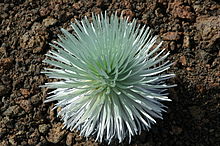Haleakala silversword
| Haleakala silversword | |
|---|---|
 |
|
| Scientific classification | |
| Kingdom: | Plantae |
| Clade: | Angiosperms |
| Clade: | Eudicots |
| Clade: | Asterids |
| Order: | Asterales |
| Family: | Asteraceae |
| Genus: | Argyroxiphium |
| Species: | A. sandwicense |
| Subspecies: | A. s. subsp. macrocephalum |
| Trinomial name | |
| Argyroxiphium sandwicense subsp. macrocephalum (A. Gray) Mérat |
|
Argyroxiphium sandwicense subsp. macrocephalum, the east Maui silversword or Haleakala silversword, is a rare plant, part of the daisy family Asteraceae. The silversword in general is referred to as ʻāhinahina in Hawaiian (literally, "very gray").
The Haleakala silversword is found on the island of Maui at elevations above 2,100 metres (6,900 ft) on the dormant Haleakalā volcano — on the summit depression, the rim summits, and surrounding slopes — in Haleakalā National Park. The Haleakala silversword has been a threatened species as defined by the U.S. Fish and Wildlife Service, since May 15, 1992. Prior to that time, excessive grazing by cattle and goats, and vandalism inflicted by people in the 1920s, had caused its near extinction. Since strict monitoring and governmental protection took effect, the species' recovery is considered a successful conservation story, although threats remain. The silversword is also found at the higher elevations on the western slope of Mauna Kea on the Big Island, Hawaii, in the Mauna Kea Forest Reserve.
The Haleakala silversword, Argyroxiphium sandwicense subsp. macrocephalum, has numerous sword-like succulent leaves covered with silver hairs. Silversword plants in general grow on volcanic cinder, a dry, rocky substrate that is subject to freezing temperatures and high winds. The skin and hairs are strong enough to resist the wind and freezing temperature of this altitude and protect the plant from dehydration and the sun.
The plant's base of leaves, arranged in a spherical formation at ground level of the plant, dominates for the majority of the plant's life—which may be greater than 50 years. The leaves are arranged so that they and the hairs of the leaves can raise the temperature of the shoot-tip leaves up to 20 °C (36 °F), thereby having adapted to the extreme high-altitude temperatures by focusing the sunlight to converge at this point and warm the plant.
...
Wikipedia

